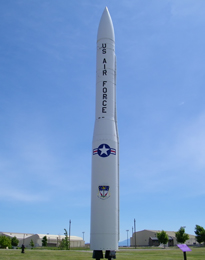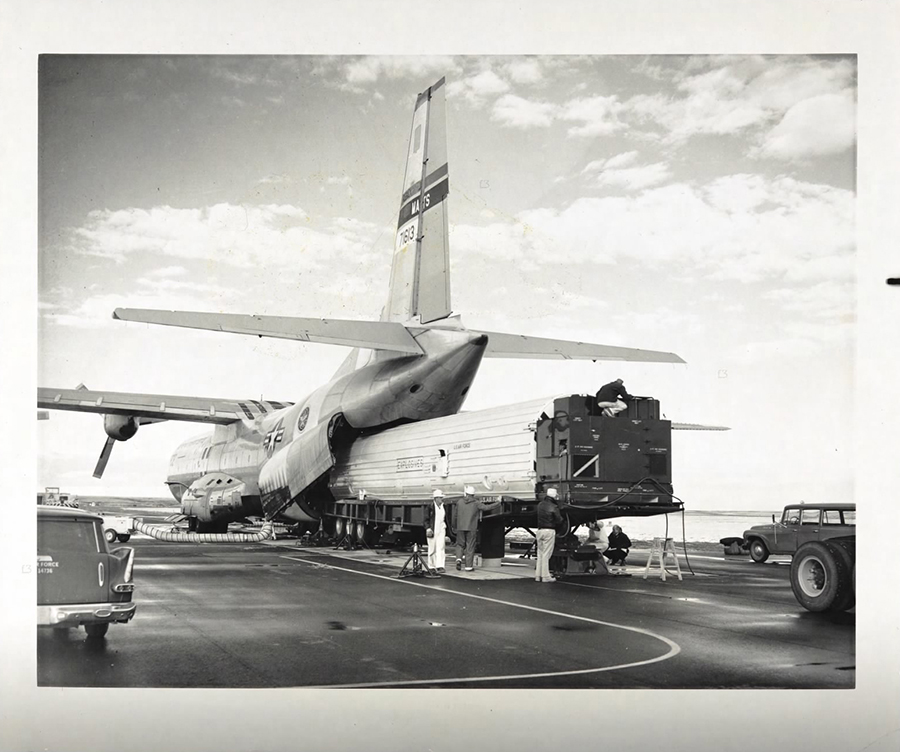Wing I - Malmstrom Air Force Base
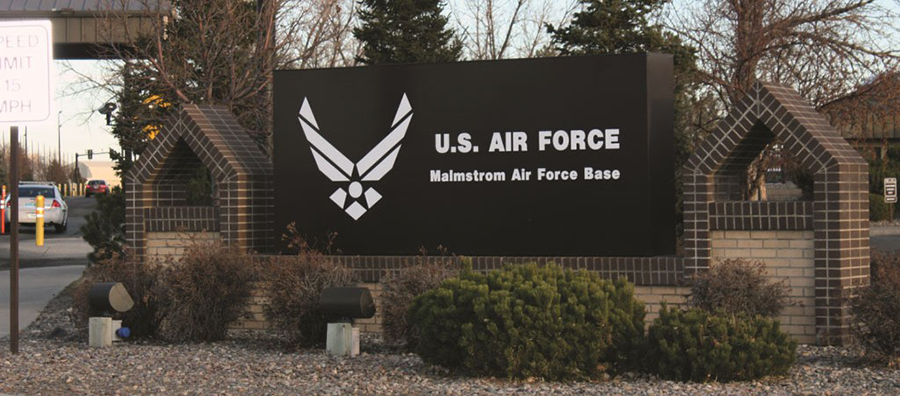
Malmstrom Air Force Base
Wing I
Malmstrom Air Force Base's 341st Missile Wing's history dates back to 1939 when the Great Falls Airport commission requested that the Secretary of War, Harry Woodring, make it possible for an Air Corps squadron to be established in Great Falls. Three years later, in May 1942, construction for an Army Air Corps base began at a site approximately 6 miles east of Great Falls. This base was initially called East Base.
This then led the base to be assigned to the Second Air Force and quite a few bombardment groups were trained at Great Falls. Two important groups, the 385th and 390th, were an important part of the raids over Germany that emphasized the importance and effectiveness of Allied daylight precision bombing.
In July 1952 the East Base had just completed a $2 million runway, when Strategic Air Command, SAC, ordered the 407th Strategic Fighter Wing, whose purpose was to protect the bombardment group, to the base at Great Falls. In 1954 Colonel Lester Harris was established as the new wing commander, and his vice wing commander was Colonel Einar Axel Malmstrom
On August 21, of that same year, 1954, Great Falls Air Force Base was tragically impacted when Colonel Malmstrom was killed in a plane accident. In the short period of time Colonel Malmstrom was the vice commander, the community of Great Falls had grown to care for Colonel Malmstrom a great deal. His great personality and charisma had touched many. Great Falls and its residents reacted to Malmstrom's death by putting forth the suggestion that the base be given a new name. On June 15, 1956 Great Falls Air Force Base was designated as Malmstrom Air Force Base.
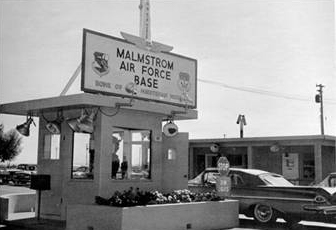
Malmstrom Air Force Base 1968
With the Cold War quickly picking up speed, December 23, 1959 marked the date when the Air Force Ballistic Missile Committee announced their approval of the selection of Malmstrom AFB to host the first Minuteman Intercontinental Ballistic Missile Base. The newly formed Corps of Engineers Ballistic Missile Construction Office was responsible for the design and would be supervising construction of the planned 15 Launch Control Facilities and the 150 Launch Facilities. The preliminary ground work would require advanced engineering, soil studies, site feasibility and land acquisition. This task was given to the Seattle District of the Corps of Engineers.
The land acquisition itself required management of 5200 tracts scattered across an area of 20,000 square miles in north central Montana. This became the largest single project ever undertaken by the Corps. At its busiest time, the Corps employed 80 people at its real estate office to deal with the 1378 land owners of the desired tracts.
The construction contract for the Montana missile field became a joint venture between the George A. Fuller Company and the Del E. Webb Corporation, who won the construction contract bid of $61.7 million. The final cost for the project as a whole came out to be $79,284,385.00.
March 16, 1961 was the date that marked the ground breaking ceremonies for this immense project. Unanticipated high water tables, an electrician's strike from November 1 through November 12, 1961, and other unforeseen problems slowed some of the construction progress. Throughout the construction project at Wing I, a total of six construction workers were killed.
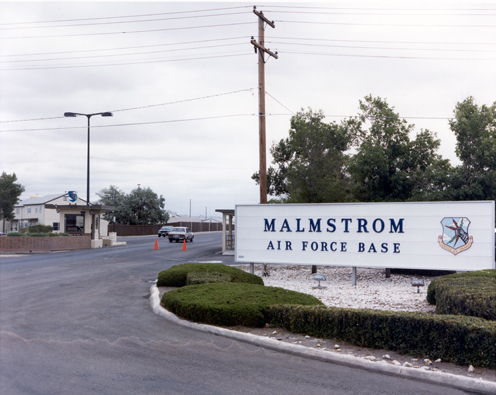
Malmstrom Air Force Base 1970
With construction well underway starting in March 1961, the Air Force activated the 341st Strategic Missile Wing on July 15, 1961. Construction continued through the year, and the first Launch Facility that had started construction in March, was completed in December 1961. The 10th Strategic Missile Squadron, SMS, was activated on November 1, 1961, and the Alpha-01 LCF, the first Launch Control Facility constructed, was completed in July, 1962.
The first Minuteman I missile arrived by train to Malmstrom AFB on July 23, 1962. Four days after its arrival, this missile was emplaced at the Launch Facility Alpha-09, earning it the title of the first Minuteman missile site. Two additional Strategic Missile Squadrons attached to the 341st Missile Wing, the 12th SMS and 490th SMS activated in March and May 1962.
Five short months later the Minuteman I missiles assigned to the nation's first Minuteman ICBM missile wing would factor into becoming a major role in the Cuban Missile Crisis.
At 11:16 AM October 26, 1962 marked the date when the 10th Strategic Missile Squadron Launch Facility Alpha-06 went on what is called "strategic alert" due to the discovery that the Soviet Union had been placing nuclear missiles in Cuba. Over the next four days, the 341st Strategic Missile Wing placed four more Minuteman I missiles on alert.
After an intense and nerve wracking 13 days, the Soviets opted to remove their missiles from Cuba. There have been statements made that President John F Kennedy stated that the Soviets backed down because they knew that he had an "Ace In The Hole," referring directly to the Minuteman I missiles that were deployed and placed on strategic alert with the 10th Strategic Missile Squadron at Malmstrom Air Force Base.
Of note, research has not been able to substantiate that President Kennedy had in fact made these statements. In looking over all of his addresses and comments made to the press and other political gatherings, the transcripts from each of these events do not document Kennedy had made the "Ace In The Hole" statements.
After an extremely busy and chaotic 28 months of construction, July 3, 1963 marked the date that the 341st Strategic Missile Wing at Malmstrom AFB with its three Strategic Missile Squadrons, became fully operational. A missile wing consists of 3 to 4 missile squadrons, each squadron consists of 5 missile flights, each flight consisting of 1 Launch Control Facility and 10 Launch Facilities. This established the total wing strength of 150 Minuteman IA missiles at Malmstrom AFB.
Two years later, construction began on the fourth and final missile squadron attached to Malmstrom AFB, the 564th SMS. This squadron was equipped with the more modern Minuteman II missile. May 5, 1967 marked the date that the 564th Strategic Missile Squadron became fully operational. With the addition of the fourth missile squadron at the 341st Missile Wing at Malmstrom AFB, made this the largest missile field in the United States, covering over 23,500 square miles. Two years later found the 10th SMS, 12th SMS, and 490th SMS at Malmstrom AFB being upgraded to the Minuteman II missile.
The 564th SMS was an interesting squadron due to a number of factors. It was sometimes called the "Odd Squad." It had many features that the other Wings did not have. The 564th SMS was also nicknamed the Deuce System, based on the technological upgrades at the 564th that gave it the capability of sending a command to launch through either the Hardened Intersite Cable System, HICS, or with the Medium Frequency antenna system that was designed into the Sylvania system.
Sylvania Electronic Systems was contracted to build the weapon system at the 564th. In constructing the LCFs and LFs, the Sylvania system had a Launch Control Capsule that was much larger than the LCCs at the 10th, 12th and 490th squadrons. The Air Force also realized early on in the construction phases of Wings I and II, that the Launch Control Capsule was more vulnerable to attack, so a second capsule was buried 60 plus feet down, alongside the Launch Control Capsule, to provide emergency electricity and support to the LCC. They also designed a Launch Support Building (LSB) to incorporate with the 50 Launch Facilities attached to the 564th. The LSB itself was buried 35 feet below ground, to give it a higher likelihood of survivability in the case of a nuclear attack.
These unique features were certainly well thought out and implemented, but it would ultimately create a system that would become obsolete of which the end result created a system that was significantly more costly to maintain. Only one other Missile Wing utilized the Sylvania system, which was Wing VI at Grand Forks AFB in North Dakota. With the deactivation of Wing VI in July 1998, parts and maintenance for the Sylvania system became more complicated to provide. In July 2007, Malmstrom Air Force Base began to deactivate the 564th, and by 2008 all 50 Minuteman III missiles had been pulled from their missile silos, and all 5 Launch Control Facilities attached to the 564th SMS were shuttered.
For further information regarding Malmstrom Air Force Base, follow the link below to their website.
564th Deactivation
To view some photos of the deactivated Launch Control Facilities and Launch Facilities attached to the 564th Strategic Missile Squadron, follow the link below.
